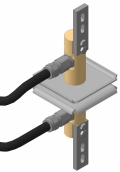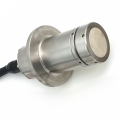Moisture meter for drywall and other sheet materials on conveyors
 FIZEPR-SW100.15.1 is a moisture meter designed for non-contact measurements of moisture content in drywall, fiberboard, chipboard, medium density fiberboard plates and other sheet materials on a conveyor line. This moisture meter can also be used to measure moisture content in timber.
FIZEPR-SW100.15.1 is a moisture meter designed for non-contact measurements of moisture content in drywall, fiberboard, chipboard, medium density fiberboard plates and other sheet materials on a conveyor line. This moisture meter can also be used to measure moisture content in timber.
The moisture meter sensor has an operating temperature of +180ºС, so it can be used in drying chambers.
The sensor contains stainless steel plates. These plates are secured on frames on the bottom and top of the controlled sheet, and gaps between the plates and the sheet must not exceed 1...2 mm.
Moisture meter operation is based on the dielcometric measurement principle, i.e. the capacitance of the capacitor formed by metal plates is actually measured. However, this solution has a significant feature: sensor cables connected to capacitor plates do not affect the capacitance measured.
The second feature of the moisture meter developed is the volumetric measurement with the determination of the total water content in the controlled volume, i.e. the measurement result is equally affected by moisture concentrated in both sheets of paper (cardboard) applied on the front and rear parts of the panel and moisture concentrated in the gypsum core.
Since cardboard and gypsum have absolutely different water absorbing and electrical properties, then the volumetric measurement only can provide reliable actual moisture values.
Industrial drywall moisture measurements are made using five moisture meter types:
- Electric-resistance moisture meters with electrodes pressed against the drywall surface on one side of the drywall sheet
- Inductive moisture meters that also measure conductivity with the exciting coil pressed against the surface on one side of the drywall sheet
- Dielectric moisture meters containing planar electrodes that are also pressed on one side of the drywall sheet
- Optical (infrared) moisture meters that measure moisture content by the light reflected from the drywall sheet surface
- SHF (microwave) moisture meters with transmitting and receiving antennas placed on the opposite sides of the drywall sheet.
For moisture meters 1, 2, 3 and 4 with the one-side sheet probing, the above-mentioned factors lead to higher measurement error.
Moreover, measurement results of moisture meters 1 - 3 are greatly affected by the size of the gap between the sensor and the sheet surface, so these moisture meters are not used for the automatic control of sheet materials on a conveyor line.
Moisture meter 5 (microwave moisture meter), at first glance, probes the drywall sheet through the entire thickness, but the reflected microwave signal is formed by the sheet surface near the transmitting antenna only. In addition, the boundary of transition from cardboard to this antenna also affects the signal coming to the receiving antenna, so moisture in cardboard affects measurement results to a greater extent than moisture in gypsum.

The figure shows an example of moisture meter installation in the drywall production line.
The electronic unit of moisture meter is located several meters away from the sensor. Measurement results are transmitted to external indication and control devices via RS-485 MODBUS RTU interface with 4-20 mA current to distances of up to 1 km.
© Design Bureau Fizelektronpribor, Ltd., 2022.12.05
































